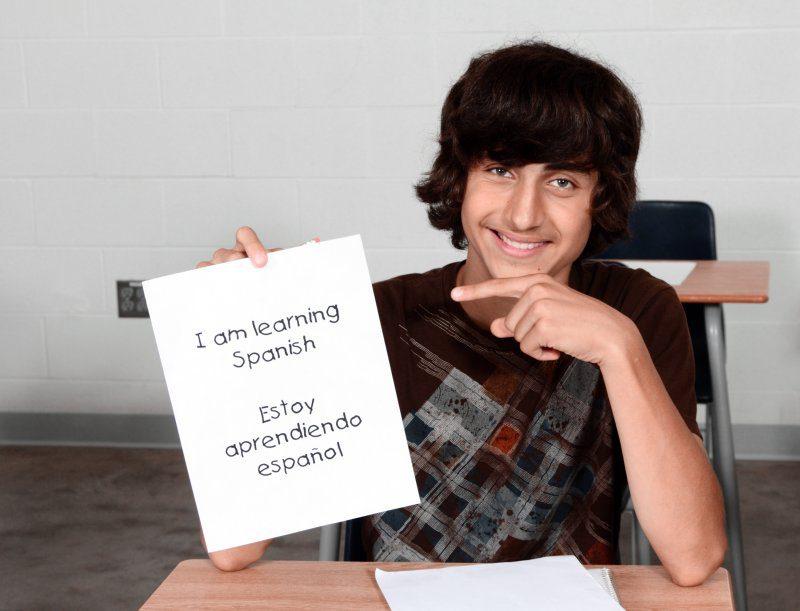Learning Spanish takes a lot of work — so don’t forget to celebrate when you’ve made progress! Here, Spanish tutor Joan B. shares the significant milestones to be on the lookout for…
No matter your age, learning a new language can be an exciting and rewarding experience. And when it comes to Spanish, there are plenty of reasons to celebrate your progress along the way!
Here are 10 milestones you can look forward to as you learn this beautiful language.
¡Felicidades! (Congratulations!)
How Can I Learn Spanish By Myself?
Anyone looking to learn Spanish by themselves has a few different options, including:
- Find a grammar book and work through it from cover to cover. This can be tedious, but it’s a fairly straightforward way to learn the basics of the language.
- Use a Spanish-English dictionary and start reading through it.
- Try online resources like websites, apps (you can find a list of the best spanish learning app options here), and even online courses.
- Find a Spanish-speaking buddy that you can practice your skills with!
By taking advantage of these resources, anyone can readily learn Spanish on their own. Of course, signing up for Spanish lessons is one of the best ways to build your skills as a Spanish speaker. Sign up for Spanish instruction here and learn more about the benefits of taking Spanish lessons below:
https://www.youtube.com/watch?v=-JPZl0DHFlg
Is Spanish Easy to Learn?
Many people believe that Spanish is an easy language to learn. After all, it uses the same alphabet as English and has similar grammar rules.
However, there are actually a number of reasons why Spanish can be difficult for English speakers to master.
For one thing, Spanish has two genders (masculine and feminine) while English only has one. This can make it confusing for English speakers when trying to remember which articles and adjectives to use.
In addition, Spanish has a lot of irregular verbs, which can make conjugation tricky. Finally, the pronunciation can be challenging for some English speakers, as there are many sounds that don’t exist in English.
While Spanish may not be the easiest language to learn, it is certainly possible with enough time and practice. With patience and a good teacher, anyone can become proficient in Spanish.
Learning Spanish: 10 Milestones to Celebrate Your Progress!
Learning a language can be an exhilarating experience, as you master concepts, increase your vocabulary, and discover a whole world of communication! When learning Spanish, there are several points along the language learning-process that are indicative of where you stand in your fluency with the language. So, when you reach these points, be sure to give yourself a pat on the back for all your hard work!
Here are 10 milestones to celebrate as you learn Spanish:
1. You can conjugate -ar, -er and -ir verbs in the present tense.
Knowing how to conjugate Spanish verbs in these three different endings multiplies the possibilities you have for expression. You’ll know you’ve reached this milestone when you can write out the following charts of conjugations:
2. You can ask simple questions using interrogative words and answer them using complete sentences.
Knowing interrogative words and being able to form questions and answers means you can have casual conversations in Spanish with a variety of individuals in daily life. For example, you can ask a shopkeeper, “¿Cuánto cuesta el cinturón?” (How much does the belt cost?), or reply to the question, “¿De dónde es usted?” (Where are you from?) with, for example, “Soy de Miami” (I’m from Miami.).
3. You can listen to an audio recording in Spanish, understand its content, and answer questions about it.
When listening to a story or other type of Spanish audio recording, you have to keep up with the rapidity of speech, quickly assimilate the meaning, and comprehend the main points and details. If you can do this, well done! If you’d like to test your comprehension, you can ask your Spanish tutor to read you a passage and ask you comprehension questions, or you can look for exercises in your textbook that offer an audio component.
4. You can recite the numbers one through 100 and use them in daily contexts.
Numbers are essential to know in Spanish, from telling time to speaking about age or the date. If you can confidently recite the numbers from one to 100 and say the time, a price, and your age, you’re competent in numbers, because you can then go on to learn the hundreds, the thousands, and beyond! Here are some examples:
Son las tres y media. (It is 3:30.)
El precio es cuarenta y nueve dólares y noventa y nueve centavos. (The price is 49 dollars and 99 cents.)
Tengo veintisiete años. (I am 27 years old.)
5. You can describe yourself — both your physical attributes and personality traits.
When you can write or say a short paragraph describing yourself, that means you are able to correctly use the verb ser (to be), descriptive adjectives, and colors in Spanish. For example:
Soy cómico pero también puedo ser serio. (I’m funny, but I can also be serious.)
Tengo los ojos azules y el pelo rubio. (I have blue eyes and blonde hair.)
6. You can talk about what you like to do and don’t like to do.
When you can express your likes and dislikes in Spanish, you are able to more richly express your preferences, you favorite activities, and your opinions. For example, could you say something along these lines in a real conversation?
Me gusta mucho el fútbol, pero no me gusta el tenis; la razón principal es porque soy aficionado del Real Madrid.
(I really like soccer, but I don’t like tennis; the main reason is because I’m a fan of Real Madrid.)
If you can do so, then you have just hit this milestone through the goalpost!
7. You can talk about your family — detailing their ages, names, professions, and other details.
Describing others in Spanish allows you to discuss news and events with others, share details about your friends and family, and generally speak about others, expanding from speaking about yourself.
Here’s a short example of what reaching this milestone might look like:
Mi hermana mayor se llama María. Ella tiene treinta y tres años, y vive en la misma ciudad que yo. María trabaja como doctora en un hospital.
(My older sister is named Maria. She is 33 years old, and she lives in the same city as I do. Maria works as a doctor in a hospital.)
8. You can describe your city.
Discussing your favorite neighborhoods or talking about the incredible Día de los Muertos festival that happens annually in your city means that you’ve hit this milestone en español! Being able to provide details about the size of your city, its neighborhoods, and its cultures and ethnicities means that you can create complex sentences, express opinions, and make use of a variety of verbs. For example:
Mi ciudad es mi ciudad favorita porque está llena de vida, de gente, y actividades, como festivales, fiestas y conciertos. Mi barrio tiene mucho que ver, muchos restaurantes y muchas actividades en que participar. Sobre todo, me encanta mi ciudad porque tiene variedad y muchas culturas distintas.
(My city is my favorite city because it’s full of life, people, and activities, like festivals, parties, and concerts. My neighborhood has lots to see, many restaurants and activities to participate in. Above all, I love my city because it has variety and lots of different cultures.)
9. You can talk about what you’re going to do on your next vacation, using the forumula, ir + a + infinitivo.
Knowing vocabulary for vacations is important, because it reflects your knowledge of leisure activities. Being able to discuss your next vacation also means that you have mastered the near future tense, in which you use the verb ir (to go) + a + a verb in the infinitive to express the idea of “going to” do something.
Here’s how you might talk about your next vacation:
En el verano, voy a ir a Puerto Rico. Cuando estoy allí, voy a ir al mar, comer pescado y nadar. Voy con mi familia, y vamos a estar en Puerto Rico por dos semanas.
(This summer, I’m going to go to Puerto Rico. When I’m there, I’m going to go to the sea, eat fish, and swim. I’m going with my family, and we are going to stay in Puerto Rico for two weeks.)
10. You can talk about your daily routine, using reflexive verbs, and what you have to do during the day.
Daily routines are full of detail, locations, and items. If you can accurately describe what you do everyday to get ready in the morning (Me ducho a las siete. [I take a shower at seven.]) and what you have to do during the day, using tengo que + infinitive (Tengo que ayudar en casa. [I have to help at home.]), you have reached this milestone with flying colors!
How Can I Quickly Learn Spanish?
Want to know how to learn Spanish fast?
If you’re looking to learn Spanish quickly, there are a few things you can do to jumpstart the learning process.
First, try immersion by surrounding yourself with Spanish as much as possible. This could mean watching Spanish-language movies and TV shows, listening to Spanish music, or reading Spanish books and newspapers.
You can also find Spanish-speaking friends or community groups to practice your conversational skills. Additionally, take advantage of technology and online resources to help you learn.
There are many online courses and apps that can provide structure and support as you work to master the language. With a little effort and dedication, you’ll be speaking Spanish in no time.
How Long Does it Take to Learn Spanish?
How long does it take to learn Spanish? This is a question that is often asked by people considering studying the language. The answer, of course, depends on a number of factors, including the person’s native language, their familiarity with other Romance languages, and their learning style.
However, most experts agree that it takes approximately 600 hours of study to reach a basic level of proficiency in Spanish. This means that, for someone who studies for two hours per day, it would take them about six months to reach a basic level of proficiency.
Of course, becoming truly fluent in Spanish would require many more hours of study, but 600 hours is a good benchmark to keep in mind when learning the language.
Learn to Speak Spanish Today!
With the world becoming increasingly interconnected, there is a growing need for people who can speak multiple languages. Spanish is one of the most popular languages to learn, due to the large number of Spanish speakers around the world and the many countries where it is an official language.
What is the best way to learn Spanish? That depends on your learning style!
Learning Spanish can be challenging, but it can also be rewarding. There are many resources available to help you learn Spanish, including online courses, books, and apps. And once you’ve learned the basics, you’ll be able to communicate with Spanish speakers all over the world.
As you reach these 10 milestones, reflect back on how far you’ve come since you started learning Spanish. You are now able to communicate effectively, express yourself and understand others! Keep up the great work as you continue learning Spanish.
So what are you waiting for? Start learning Spanish today!
 Post Author: Joan B.
Post Author: Joan B.Joan B. lives in Carmichael, CA and has been teaching high school Spanish for more than 18 years. A lover of language, she’s studied French, Arabic, and Italian and spent time living in Spain. Joan aims to help students improve on tests and increase their conversational ability when traveling to Spanish-speaking countries. Learn more about Joan here!
Photo by Sarah Reid
Suzy S.


